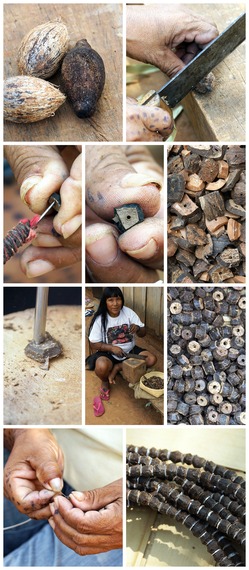Sergio Polignano, on behalf of Forest Trends
Eliza Suruí sits on a palm mat she wove herself, in the shade of her family's maloca, or dwelling. It is a hot September afternoon in the Brazilian Amazon. She picks a tucun nut from the basket in front of her and using a large, very sharp knife, carefully breaks the shell into several pieces. With a foradera, a pointed tool, she pierces a fragment, creating the smallest of holes. Then, reaching again for her knife, she whittles the shell into a rounded bead, not more than three millimeters in diameter. "It's only the beginners who cut themselves," says Kabena Cinta Larga, one of Eliza's fellow artisans. "It's not as dangerous as it seems, once you have practice."
The women are part of the Paiter-Suruí community, a group of indigenous people who live in more than 20 villages deep within the Amazon in the Brazilian states of Rondônia and Mato Grosso. The Suruí's first contact with the world beyond their villages and surrounding forest came in 1969, after which the community was decimated by disease. Now, they are gradually recovering and strengthening their community under the leadership of Chief Almir Suruí, successfully fending off threats to their home, the forest, from illegal mining and logging.
On this hot day, the women create bead after bead after bead, until there are enough to make a necklace or a yokopiab (a traditional sash used by Suruí men during rituals), which can be up to six meters in length. After every bead is threaded onto a hand-spun cotton string, the women sand and polish the beads until they are a shiny dark brown. Each necklace can take a month or longer to compete, as the women work on handicrafts like these between tending children and crops, preparing food, cleaning their homes, and other daily tasks.
From Beads to Opportunity
Until now, the women have been selling pieces individually, only when an opportunity has arisen. But on this day Eliza, Kabena (who grew up in a neighboring people, the Cinta Larga, and married into the Suruí), and others have just returned from the launch of a store exclusively to sell the handicrafts of the Suruí women. More than 150 people attended the store's launch, including local politicians, business people, and supporters from non-governmental organizations, among others.
As they work making the beads and threading them into necklaces, the women speak with excitement about their craft and something new: the opportunity it affords them. Kabena says she will sell her work to help pay for the healthcare and education costs of her nine children and to invest back into her handicrafts.
The store is part of an ongoing effort to save the Suruí forest by nurturing economic activities that keep it alive, as opposed to activities like logging and mining that have the opposite effect.
The store offers a way for locals and tourists alike to purchase Suruí jewelry, baskets, pottery, and other handicrafts. "This store represents another hard-fought achievement for the Suruí people, especially the women," says Tonica Suruí, recently chosen as the first Coordinator for Women's Activities for the Metareilá Association, a group that works to defend and preserve the autonomy and the cultural and territorial heritage of the Suruí people. "It is an opportunity for the women to help their families economically."
Revival of a Lost Art -- and Looking to the Future
Indeed, some of the Suruí handicrafts were once a lost art, with only a few of the older women in the tribe maintaining the traditions. Recently, though, more of the community's women have come to realize the importance of keeping these traditions alive for many reasons, not the least of which is the empowerment that comes from earning income from the store's sales. "Making the necklaces is a way for me to maintain my culture," says Kabena's daughter, 16-year-old Silvana Suruí, also stringing tucun nut beads. "I want to keep our traditions alive."
Maintaining their cultural traditions, including handicrafts, is an important part of the Suruí 's 50-year life plan for their territory. This plan has developed to include the sale of carbon credits, whereby the community receives funds for maintaining the huge swath of rainforest they have always called home. Their stewardship of these trees, rather than clear-cutting the land for mining or logging, is a vital tool in our planet's mitigation of global warming and climate change.
Through an innovative financing project called the Suruí Forest Carbon Project -- which is supported by the non-profit Forest Trends -- the Suruí became the first indigenous tribe in the Amazon to globally to earn carbon credits under internationally recognized standards for maintaining the carbon that is held in standing trees. The project can serve as a model for other indigenous people across the Amazon who do the crucial work of preserving endangered tropical rainforests.
Empowering Suruí Women and Beyond
The proceeds from the carbon project, as well as support from the IKEA Foundation via Forest Trends, enable the Suruí women to fully engage in activities -- like the handicrafts and running the new store -- that use forest products in a sustainable manner to support their families and livelihoods.
In June, Suruí women attended a training workshop to help them better understand how to manage the store. Also at the workshop were local business people and women from another indigenous community, the Yawanawá, who, like the Suruí, are embracing innovative methods to enable them to maintain the forest rather than clear-cut it. The women learned about inventory, stock and control, general business management techniques, and the legalities of the business.
A key aspect of the store's business model is that it is run solely by women and only carries handicrafts made by the women of the community. For now, the store consigns the handicrafts on display. Each piece is labeled with the name of the artisan who created it, and that woman receives the income when that piece is sold. Aside from the importance of the additional income to their families, there is great pride that women are in charge, as well as pride in the creation of the individual pieces, each unique and beautiful.
"I love making earrings," says 21-year-old Fabiane Suruí. "Each pair is its own work of art." When asked what she wants to do with her income, she replies, "Finish my education and travel. I'd love to see snow."
Indigenous People and the Fight Against Climate Change
Last month, more than 400,000 people gathered in New York City to march for action on climate change, in the People's Climate March. Leading the march were indigenous people, as part of the contingent of participants whose motto was "Frontlines of Crisis, Forefront of Change." Their inclusion was an important signal that the world is finally looking to communities like the Suruí for answers -- and for hope.
In December, world leaders will gather in Peru for climate change negotiations, at COP 20. As the world turns its focus to the seemingly intractable problems of global warming, already heavily impacting our Earth, a young woman's dreams of snow and learning on a hot day in a remote village in Brazil may seem irrelevant. Yet Fabiane's earrings and Eliza's beads and the Suruí store -- and indigenous people like the Suruí, who are our planet's most effective stewards of our forests -- are undoubtedly a mighty and quantifiably valuable part of the climate change solution.
Today, you have the chance to become part of this work. Until Dec. 5 every gift to Forest Trends will be matched by the Skoll Foundation. Your gift helps protect forests and other threatened ecosystems and contributes to local livelihoods and conservation.
This report was filed by Rebecca Anzueto and Ann Clark Espuelas.

